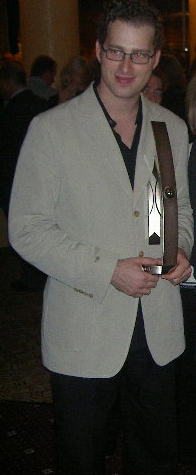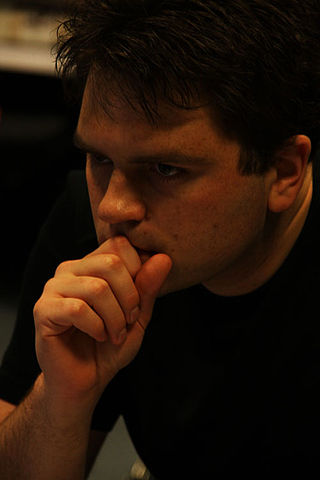
Carl August Nielsen was a Danish composer, conductor and violinist, widely recognized as his country's most prominent composer.

Hugo Emil Alfvén was a Swedish composer, conductor, violinist, and painter. Alfvén was one of Sweden's principal composers. His "Swedish Rhapsody”, written when he was 31, is still one of the best-known pieces of Swedish music. After extensive European travels to develop his musical skills, Alfvén taught composition, before conducting choirs and orchestras. In 1954 he made the first Swedish classical stereo recordings. Hugo Alfvén’s extensive musical archive is held at Uppsala University, where he was music director for twenty nine years.
Alfred Whitford (Fred) Lerdahl is an American music theorist and composer. Best known for his work on musical grammar, cognition, rhythmic theory and pitch space, he and the linguist Ray Jackendoff developed the Chomsky-inspired generative theory of tonal music.

Per Nørgård is a Danish composer and music theorist. Though his style has varied considerably throughout his career, his music has often included repeatedly evolving melodies—such as the infinity series—in the vein of Jean Sibelius, and a perspicuous focus on lyricism. Reflecting on this, the composer Julian Anderson described his style as "one of the most personal in contemporary music". Nørgård has received several awards, including the 2016 Ernst von Siemens Music Prize.
Ib Nørholm was a Danish composer and organist.

William Quincy Porter was an American composer and teacher of classical music.
Symphony No. 4, Op. 29, FS 76, also known as "The Inextinguishable", was completed by Danish composer Carl Nielsen in 1916. Composed against the backdrop of World War I, this symphony is among the most dramatic that Nielsen wrote, featuring a "battle" between two sets of timpani.

Nikolaj Szeps-Znaider is a Danish violinist and conductor.

The Danish composer Carl Nielsen wrote his Symphony No. 3 "Sinfonia Espansiva", Op. 27, FS 60, between 1910 and 1911. Around 35 minutes in length, it is unique in his symphonic output for having vocal parts, specifically wordless solos for soprano and baritone in the second movement.
Symphony No. 1 in G minor, Op. 7, FS 16, is the first symphony of Danish composer Carl Nielsen. Written between 1891 and 1892, it was dedicated to his wife, Anne Marie Carl-Nielsen. The work's première, on 14 March 1894, was performed by Johan Svendsen conducting the Chapel Royal Orchestra, with Nielsen himself among the second violins. It is one of two symphonies by Nielsen without a subtitle.
Hanna Kulenty is a Polish composer of contemporary classical music. Since 1992, she has worked and lived both in Warsaw (Poland) and in Arnhem (Netherlands).

Tomi Räisänen is a Finnish composer.

Krzysztof Aleksander Janczak is a Polish composer of film, classical and TV music, sound designer and musicologist.

Julia Gomelskaya was a Ukrainian composer of contemporary classical music.
The MA Festival Brugge, short for the festival Musica Antiqua Bruges in Bruges, Belgium, is a festival of early music and historically informed performances, started in 1960. The program includes concerts, master classes, conferences, visits in the region, exhibitions, instrument market, and international competitions that concentrates in a three-year cycle on organ, harpsichord, pianoforte and other period instruments, vocals, and baroque ensembles. The specialised festival is part of the Festival of Flanders.
Marcel Chyrzyński is a Polish composer. He has been described as "a polystylist with an enormous sense of humour, and a lover of rhythm and jazz improvisation". Chyrzyński's works have been performed throughout Europe, as well as in South Korea, Australia, New Zealand, Japan, the USA and Canada.
The International Violin Competition Leopold Mozart in Augsburg is an international violin competition, held every three years in commemoration of Leopold Mozart (1719–1787), the father of Wolfgang Amadeus Mozart. It is the goal of the competition to encourage young violinists and to promote Augsburg's reputation as a German Mozart city. The competition is a member of the World Federation of International Music Competitions (WFIMC) in Geneva. It is run by the Leopold Mozart Board of Trustees in cooperation with the city of Augsburg and the Leopold Mozart Center of the University of Augsburg. Further partners are the Bavarian State Ministry for Science, Research and Art, the District of Swabia, Bavarian Radio and the University of Augsburg.

Partita, five reminiscences for large orchestra is a collection of musical pieces by Jörg Widmann. It was written for the 275th anniversary of the Leipzig Gewandhaus Orchestra in 2018.
The bassoon repertoire consists of pieces of music composed for bassoon as a principal instrument that may be performed with or without other instruments. Below is a non-exhaustive list of major works for the bassoon.

The Danish composer Carl Nielsen (1865–1931) was one of the most important symphonists of the early twentieth century: his six symphonies, written between 1892 and 1925, are the core of his oeuvre. Many of classical music's conductor–orchestra partnerships have recorded the complete set, colloquially known as the "Nielsen cycle". Specifically, the standard cycle includes:









